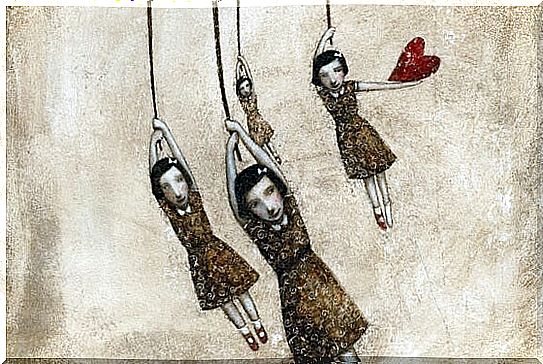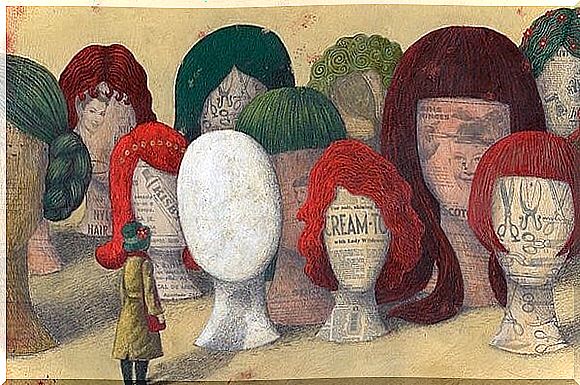Narcissistic Families Cause Emotional Pain
Narcissistic families are like spiders. They trap their children in a web of emotional suffering.
In this kind of family dynamic, there is always one person who puts their own needs ahead of everyone else’s. In this way, that person acquires absolute power. He uses that power to manipulate others. His goal is to feel that he is taken care of, that he is recognized and that he is valued at all levels.
People who grow up in a dysfunctional environment like this say their family looks perfect on the outside. But in the family they live in a real hell. It is not easy to get out of this situation.
The bonds that develop in each of these families have their own fingerprints. Still, they share some important common aspects.
The most characteristic feature of narcissistic families is that there are very specific but unspoken rules. These appointments revolve around one person. This family member takes away the rights and recognition of everyone else.
It often happens that the children lack an emotional bond with their parents. The parents look down on the children and subject them to silent but prolonged abuse.
The truth about unhealthy family dynamics is often silenced forever by cutting down certain branches of the family tree.
Once the child is mature and able to finally escape the humiliating environment of his childhood, he takes on the “bad kid” stamp. Because he abandoned the family and had the nerve to cut ties.

scapegoats
Sara is twenty years old and studying psychology. She no longer lives with her parents for a year. Now she wants to start her life again remotely and she wants a perspective for herself. Sara wants to put the pieces of herself back together so she can overcome her past and try to move on.
Her scars come from the narcissistic family she grew up in. Her parents played the game of power.
Sara’s father suffered from some sort of personality disorder. She now knows that thanks to her studies. But no one ever dared suggest him to seek professional help. Because the context in which he lived gave him the opportunity to function well, even if he had this disorder.
Her mother was a handy resource in this area. But she too was a victim of the father. For she gave in to all his needs and never managed to set boundaries.
Sarah was the scapegoat. She was the subject on which her narcissistic father projected everything. Which means she had to absorb his frustrations, failures, and anger.
However, her older sister was the golden child. He molded her into an image of himself. And for some reason he also thought she was more talented than Sara. The situation had such an effect on Sara that she began to think she was inferior anyway.

Common Traits of Narcissistic Families
When you’re part of this family portrait, it’s not easy to escape. For growing up in this means adopting many destructive rules, thought patterns, and ideas that have a significant impact on a child’s mind. These are some common characteristics of narcissistic families:
- You act like your family is the best. You don’t tell anyone outside the family what’s happening. Because narcissistic families are very concerned about their image. In fact, they often use the following words ‘we have no problem, we are the perfect family’.
- The parents are totally dysfunctional. In a normal family, the role of the parent includes the following tasks: providing security, affection, education and emotional care for the children. In narcissistic families, the child has one obligation: to take care of his parents.
- Effective communication is lacking. The type of communication most common in narcissistic families is triangular. In other words, the family members are never direct. Their behavior is passive-aggressive and based on tension and mistrust. In Sarah’s case, for example, any command, desire, or comment that her father directed toward her came through the mother. He used her as an intermediary to get Sara to obey.
How do you get away from the environment of a narcissistic family?
In Huckleberry Finn , Mark Twain wrote that we should not let our family wounds define us. There is always a piece of your true self hiding somewhere in a corner of your heart and still smiling and alive. This bit can give you a nudge from absolutely nothing to being happy.
To remove yourself from that dull, toxic environment, consider the following:
- You need to understand that people with a history of narcissistic behavior generally don’t change easily. There are therapies they can try. But very few people take the step and admit that something is wrong.
- Try not to feel guilty for what your narcissistic family members can do. Use cognitive strategies to protect yourself. This way you avoid ending up in the situation Sara was in. Then she thought there was nothing right about her.
- It doesn’t make much sense to talk to a narcissist about your emotions. He will probably hurt you even more. Limit yourself to the following words ‘I understand what you are saying, but I will not allow you to…’, ‘You must realize that you have no right to…’ and ‘I am asking you from now on…’. Set boundaries in an assertive way.
- Find allies in your family or in your social circle who can understand and support you.
- Create distance between you and the narcissistic family member. That doesn’t mean you have to cut your ties with him completely. But make sure you clearly see what situations you can control and how often you want to see him.

It is not only unhealthy to live in an environment where emotional principles are disrupted. Because it is unbearable, especially for the children.
But when those children grow up, they are often unable to say no to people. They also fail to see that they have the right to set boundaries. In addition, they have a hard time expressing their own desires and needs and choosing not to tolerate something.









